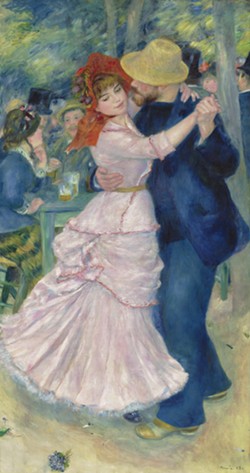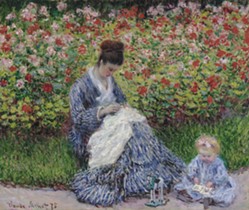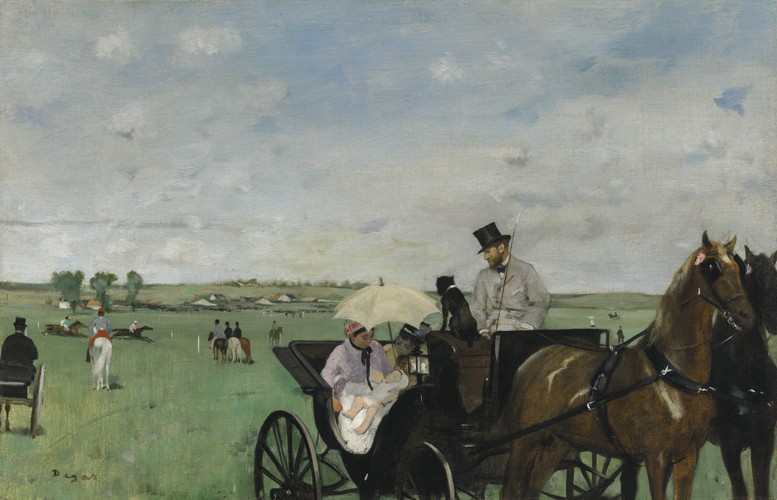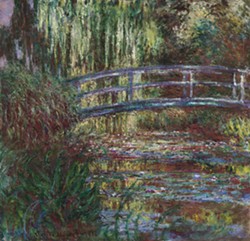Well, at least the works of those artists and others who cut their teeth (and brushes) during the heyday of French Impressionism in the late 19th century. And after a COVID-delayed and truncated showing at the National Gallery of Victoria in Melbourne, Australia this summer, some 90 paintings and 15 prints were on their way back to their permanent home at the Museum of Fine Arts, Boston.
But through some Curatorial Black Magic and the silver-tongued workings (and fundraising) of Museum of Fine Art, Houston Director Gary Tinterow, the exhibit Incomparable Impressionism from the Museum of Fine Arts, Boston has landed here and will be on view through March 27. It is the only U.S. stop for the collection.
“It was a wonderful arrangement that happened at a curious moment. He’d seen the catalog and knew the works from his time as a graduate student at Harvard,” says Helga Aurisch, MFAH Curator of European Art. “And it was sequestered in Australia. But he was able to talk to his friend in Boston, and this exquisite show will get to be seen by more people now.”
Today, of course, the French Impressionists are the Rock Stars of Painting. Their names familiar to even the general populace, and their most famous works found on everything from T-shirts and tote bags to prints and men’s ties (not to mention the two competing Immersive Van Gogh Experiences currently running in Houston).
But it wasn’t always that way. In fact, these artists were considered radicals when they first began working in the 1860s. And as Aurisch explains, had to create their own opportunities after being soundly rejected by status quo of the art world.
“They were really the rebels and struck out on their own when they had a hard time getting their works accepted by the Salon, which was the official juried show. And all the jurors were professors at the art schools in Paris. And they rejected this style, which was very contrary to their own academic style,” Aurisch continues.
“The Impressionists’ work looked like sketches to them. Like they were unfinished and rough. So, these new artists grouped together and arranged their own exhibits, which they did in the spring of 1874. But at the time they didn’t call themselves Impressionists. They were independent artists. They drew less people, and the press hated them. So, they struggled for years before finding some acceptance in the 1880s.”

"Dance at Bougival" by Pierre-Auguste Renoir, 1883,
© Museum of Fine Arts, Boston/All Rights Reserved
Of all the artists whose works are on display in Incomparable Impressionism, there are more works by Claude Monet (1840-1926) than any other. Coming in next would-be Pierre Auguste-Renoir (1841-1919). The pair were “fast friends” according to Aurisch, even if their styles and subject matter were often different.
As the exhibit’s catalog points out, Renoir was more of an extrovert who concentrated on paintings of people and craved interaction (“I suffer from the illness of experimentation,” he once famously said). Monet, by comparison, liked to work alone and focused on landscapes and his famous depictions of bodies of water.
Aurisch relays a story in which the two friends decided to set up their easels side-by-side to capture the scene of bathers by the Sienne River at a place just outside of Paris. “They painted the same scene, and it’s very interesting. Monet concentrates on the landscape but has a few figures. And Renoir paints the figures in detail, with some landscape. They each had [specialties], and Monet didn’t become a pure landscapist until the late 1870s.”
She adds that Monet’s development as a painter is “cleaner” and shows more of a linear trajectory, while Renoir would often work in one way with subject matter and style, reject it, then move on to something different. “Renoir was the portraitist of the Impressionists. And he especially liked painting beautiful young women. It was his delight,” Aurisch adds.
And indeed, the exhibit contains a balance of portraits, landscapes, still lifes, architecture and works in which the artists utilized models. Probably the most famous painting of them all is Renoir’s Dance at Bougival. The familiar image shows couple dancing in an outdoor setting with much of the bearded man’s face hidden by a rakishly tilted yellow hat, and his partner in a lush pink dress and red bonnet with eyes closed, smiling in contentment.
Aurisch drops the knowledge bomb that while Renoir’s male model is lost to history, the woman in this “monumental, realistic and lovely” work is most likely Suzanne Valadon, who worked as a model for several painters at the time, and later became one herself (the MFAH has one of her self-portraits in their collection, meaning she appears on display twice). It’s also one of a series of three Renoir paintings depicting couples dancing.
The catalog for the show also talks about the importance of mentors to the Impressionists, and in many cases how they outshone these teachers. As Monet did with his mentor, Eugène Boudin.

"Camille Monet and a Child in the Artist’s Garden in Argenteuil," by Claude Monet, 1875.
© Museum of Fine Arts, Boston/All Rights Reserved
“That’s a good question! I don’t think so. Monet was incredibly grateful to Boudin and has said that he owes everything to him,” she says. “He showed Monet how to paint outdoors. And then Boudin became influenced by Monet and Impressionism later in his life. They had a back-and-forth influence,” Aurisch says. “And all three of Pissarro’s [students] revered him for their entire lives.”
The catalog for the show also discusses how the advent of metal tubes to store oil paint in made the Impressionists much more mobile and able to work outdoors on their easels and canvasses. “The idea of putting paints into tubes was actually patented by an American in 1841, and that came from toothpaste!” Aurisch says.
“He thought it would be very helpful to all painters. Because in centuries past, you had to grind your own paint and mix it and if you wanted to take it with you, you had to transport it in sheep’s bladders or something that’s bound to rip and spill. It was a messy business! But by this time, the paint tubes were available in artist’s shops. It had a huge impact.”
She adds that it was particularly beneficial to artists from the Barbizon School, of which there are many represented in Incomparable Impressionism. The group takes its name from the hamlet of Barbizon, France. It’s on the edge of the large Forest of Fontainbleau about 55 kilometers southeast of Paris and is seen in many of the works here.
Finally, when asked if Gary Tinterow, say, knocked on her office door and told he she could take one painting from the exhibit home tonight, which one would she pick for her living room?
“Dream on!” she laughs heartily. “I would probably take something by Monet. Either The Water Lily Pond with the Japanese footbridge or Camille Monet and a Child in the Artist's Garden in Argenteuil. It’s the high point of Monet’s High Impressionist style. The light is flickering and the subject so engaging. But I can only have two?
Incomparable Impressionism from the Museum of Fine Arts, Boston runs through March 27, 2022, at the Museum of Fine Arts Houston in the Beck Galleries, 5601. For info, call 713-639-7300 or visit mfah.org/exhibitions. Tickets $22 and up.



